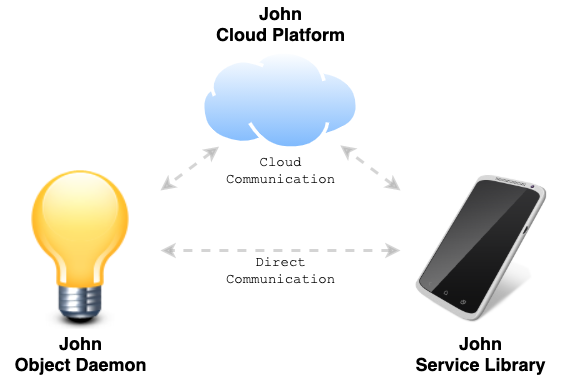
The John O.S. Platform is a next-gen IoT Platform.
This platform allows anybody to create custom IoT Solutions in minutes.
Register your connected objects to the JOSP EcoSystem, then interact with them from any software enabled.
That's it! Your IoT Solution is ready.
This is the JOSP Docs official website.
Within those pages you can find all JOSP Project's related documentation.
Because the IoT world introduce many new concepts and there are many IoT Actors with different levels of knowledge, the JOSP Docs are organized in 3 main sections.
- the 'What is?' section describe what is IoT and introduce the JOSP Project
- in the Guides section there are all user's guides grouped by End User, Makers and Developer
- finally, in the Reference section are contained all references of JOSP Project's software and tools
What the JOSP Project provides?
The JOSP Project not only provide a ready-to-use JOSP EcoSystem, with the Public JCP platform, but also all EcoSystem's components as Open Source software and libraries.
In the JOSP Projects, an EcoSystem can be composed by 3 main components:

- John Object Daemon
It is the JOSP Object's agent. This software is generally installed into the connected object (or locally near him) and translate the JOSP's messages to firmware calls. - John Service Library
It is the software library that can be included in 3rd party software to enable the JOSP support. Once a software incudes the JSL Library it becomes a JOSP Service and can interact with JOSP Objects. - John Cloud Platform
It's the cloud component for JOSP Solutions. This cloud platform, mainly, provides the cloud communication between JOSP Objects and Services.
Those components can be used to setup your own JOSP EcoSystem.
Or to create JOSP Objects and Services as IoT Components to be used in JOSP Solutions.
The JOSP Project provides also a set of tools and guidelines to manage and design JOSP Objects and Services:

- How End Users can manage their connected objects from a single point of reference
- The Johnny Services as user interfaces to handle JOSP Objects
- The John Remote Object as tool to manage JOSP Objects on remote devices
- How Makers can create a connected JOSP Object or integrate existing connected objects with a JOD Distribution
- The JOD Distribution TEMPLATE as starting point for custom JOD Distributions
- All published JOSP Objects and JOD Distributions (they can be used as examples)
- How Developers can implement IoT features in their Mobile, Desktop and Web software
- All published JOSP Services (they can be used as source of inspiration)
Getting started
Depending on your purposes, you can start reading related documentation to:
End Users
Create a JOSP Solutions
- Register a new user's account to the Public JCP
- Connect and register a JOSP Object
- Grant access to objects to desired JOSP Services
- Share JOSP objects with other users
Makers
Create custom JOSP Objects or JOD Distributions
- Understand how objects are represented to the JOSP EcoSystem
- Choose the object to connect nature: local, protocol, http or other
- Create, build test and release a custom JOD Distribution following JOSP Objects design guidelines
Developers
Implement IoT features in their own software
- understand how objects are represented to the JOSP EcoSystem
- choose which type of service to develop
- integrate the JSL Library and start interact and manage JOSP Object
Collaborate
This is an Open Source project, and there are many ways to help and collaborate in the JOSP Project:
- Share your JOSP Objects's as JOD Distributions
- Implement JOSP Services and add them to JOSP Services list
- Help to resolve bugs and implement new features to the JOSP Core project
- Improve existing docs or write new Guides and HowTos
At the same time we are always looking for new use cases and demos. So, whether you have just an idea or are already implementing your IoT solution, don't hesitate to contact us. We will be happy to discuss with you about tech decisions and help build your solution with John’s component.
Please contact us at tech@johnosproject.com.